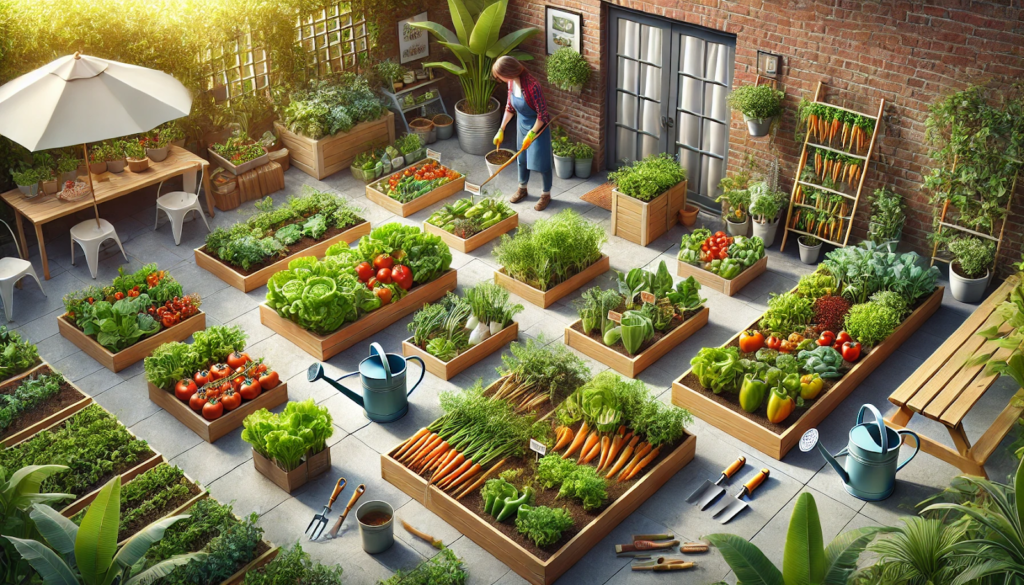Growing your own vegetables at home is one of the most rewarding experiences you can have. Not only does it save money, but it also gives you access to fresh, chemical-free produce right from your backyard, balcony, or patio. With the right guidance, anyone can start a productive vegetable garden—no matter how much (or how little) space you have.
This article will walk you through all the essential steps to start growing your own vegetables at home.
Benefits of Growing Your Own Vegetables
- Freshness: Harvest vegetables at peak ripeness for the best flavor and nutrition.
- Cost Savings: Save on grocery bills by producing your own food.
- Sustainability: Reduce your carbon footprint and food waste.
- Control: Know exactly how your food was grown—no pesticides or synthetic fertilizers.
- Therapeutic Value: Gardening improves mental health and reduces stress.
Step 1: Choose the Right Location
Your garden’s success depends heavily on where you grow your vegetables.
Key Factors:
- Sunlight: Most vegetables need 6–8 hours of direct sunlight daily.
- Drainage: Avoid areas where water pools after rain.
- Access: Choose a spot close to water sources and easy to reach for maintenance.
Great Locations:
- Raised garden beds
- Container gardens on patios or balconies
- Window boxes or hanging planters for herbs
Step 2: Decide What to Grow
Choose vegetables based on:
- Your climate
- Space availability
- Your family’s preferences
Easiest Vegetables for Beginners:
- Lettuce
- Tomatoes (especially cherry varieties)
- Green beans
- Radishes
- Carrots
- Peppers
- Spinach
- Zucchini
Tip: Start small with 3–5 types of vegetables and expand as you gain confidence.
Step 3: Choose Between Containers, Raised Beds, or In-Ground
Each method has pros and cons:
Containers:
- Ideal for small spaces
- Requires frequent watering
- Offers soil control and mobility
Raised Beds:
- Great for controlling soil and drainage
- Less bending required
- Requires initial setup and materials
In-Ground Beds:
- Cheapest long-term option
- Best for large gardens
- May need soil improvement
Step 4: Prepare the Soil
Healthy soil = healthy plants. Test your soil if possible, or improve it by adding:
- Compost: Enriches with nutrients and organic matter
- Aged manure: Excellent natural fertilizer
- Mulch: Helps retain moisture and suppress weeds
- Perlite or sand: Improves drainage in clay-heavy soil
Ideal pH for most vegetables: Between 6.0 and 7.0
Step 5: Planting Your Garden
Each vegetable has specific spacing and planting depth requirements.
Tips:
- Follow seed packet instructions or transplant guidelines
- Stagger planting times for a continuous harvest
- Companion plant (e.g., basil with tomatoes) to maximize growth and pest control
Tools You’ll Need:
- Trowel
- Garden gloves
- Watering can or hose
- Labels or markers
Step 6: Watering Wisely
Water is vital, but overwatering can cause root rot.
Guidelines:
- Water early in the morning
- Water at the base, not on leaves
- Keep soil moist but not soggy
- Containers dry out faster—check daily
Step 7: Feeding Your Plants
Use natural fertilizers for steady growth and yield.
- Compost tea
- Fish emulsion
- Worm castings
- Balanced organic fertilizers (5-5-5 or 10-10-10)
Feed every 2–4 weeks during growing season.
Step 8: Pest and Disease Management
Prevention is key.
Natural Control Methods:
- Neem oil spray
- Diatomaceous earth
- Hand-picking pests
- Companion planting with pest-repellent herbs like basil and marigold
Regularly inspect leaves for signs of trouble like yellowing, holes, or mold.
Step 9: Harvesting at the Right Time
Picking vegetables at the right time ensures the best flavor and encourages more production.
General Tips:
- Harvest lettuce and spinach when young and tender
- Pick tomatoes when fully colored and slightly soft
- Pull root crops like radishes and carrots when they reach mature size
Step 10: Extend the Growing Season
Maximize productivity with these tricks:
- Use cold frames or row covers in cooler months
- Start seeds indoors in early spring
- Grow fast-maturing varieties for multiple plantings per season
Keeping It Going: Garden Maintenance
- Weed regularly to prevent competition
- Rotate crops yearly to reduce soil-borne disease
- Add compost or organic matter each season
- Keep a gardening journal to track successes and lessons
From Seed to Table: Enjoy the Harvest
Growing your own vegetables at home is more than just a hobby—it’s a way to connect with your food and nature. With a little planning, regular care, and the right resources, your home garden will provide fresh, delicious produce all season long. And there’s nothing more satisfying than eating what you’ve grown yourself.






